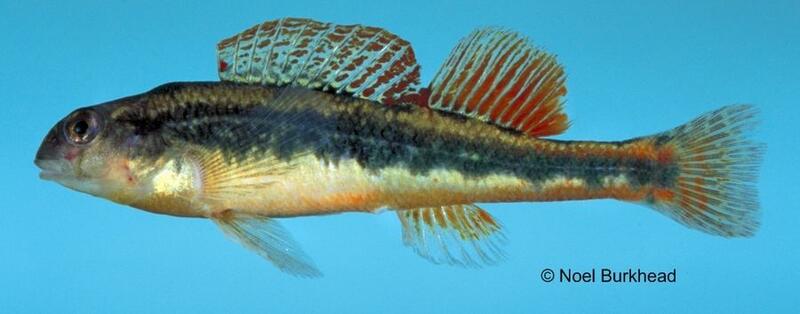







Loading profile. Please wait . . .
Etheostoma duryi Henshall, 1889
Blackside Snubnose Darter




Federal Protection: No US federal protection
State Protection: Rare
Global Rank: G4
State Rank: S2
Element Locations Tracked in Biotics: Yes
SWAP 2015 Species of Greatest Conservation Need (SGCN): Yes
SWAP 2025 Species of Greatest Conservation Need (SGCN): Yes
2025 SGCN Priority Tier: High Conservation Concern
Element Occurrences (EOs) in Georgia: 7
Habitat Summary for element in Georgia: Small to medium streams, gravel to cobble bottoms; riffles and pools
The blackside snubnose darter grows to a maximum length of 70 mm (2.8 in), with a blunt snout typical of the "snubnose darter" group. Eight to nine dark saddles cross the tan dorsum and about 9 dark blotches form a midlateral stripe; the fourth dorsal saddle is often the darkest and may extend ventrally to the midlateral stripe. The venter is pale yellow. A small orange spot occurs at the front of the first dorsal fin, and a black teardrop descends below the eye. Males are slightly larger than females. Breeding males have a green throat and chin, an orange breast and belly, and brick red pigmentation in the dorsal fins.
The blackside snubnose darter is very similar to the snubnose darter (Etheostoma simoterum). The snubnose darter has a narrow but distinct frenum (vs. no frenum), two separate spots in the middle of the caudal fin of juveniles (vs. a single median caudal spot or median caudal spots fused together in juveniles), and a more steeply sloping (i.e., blunt) snout.
The blackside snubnose darter inhabits small creeks and rivers, living in pools and slowly moving riffles with gravel, cobble, boulder or bedrock substrata.
Benthic aquatic insects.
Spawning occurs from March to early May. The aggressive males may chase one another and follow females as they search for a site to attach their eggs. The accompanying male embraces the female in an S-shaped position to fertilize the eggs as the female lays them one by one on the surfaces of rocks. Sexual maturity is reached at age one and the maximum life span is likely three years.
This species is vulnerable to standard sampling methods such as seining and backpack electrofishing. Nuptial males should be photographed with their fins erect, which can facilitate accurate identification.
The blackside snubnose darter is found only in the Tennessee River drainage in Alabama, Tennessee, Georgia, and extreme northeast Mississippi. In Georgia, this species is restricted to the Chickamauga Creek watershed in the northwest corner of the state. Check the [Fishes of Georgia Webpage](http://fishesofgeorgia.uga.edu/index.php?page=speciespages/species_page&key=ethedury) for a watershed-level distribution map.
Habitat degradation in small streams, including accelerated erosion and sedimentation caused by land-disturbing activities, poses the greatest threat to the blackside snubnose darter.
| Threat 1 | Threat 2 | Threat 3 | |
|---|---|---|---|
| General Threat | Pollution | Pollution | None |
| Specific Threat | Agricultural & forestry effluents | Domestic & urban waste water | None |
The blackside snubnose darter is only represented by a handful of occurrences in the Chickamauga Creek watershed. However, it has been collected in the early 2000s in both the Chickamauga and Lookout Creek systems.
Conserving populations of the blackside snubnose darter depends on maintaining and improving habitat quality in small streams by eliminating sediment runoff from land-disturbing activities such as roadway and housing construction, maintaining and restoring forested buffers along stream banks, eliminating inputs of contaminants such as fertilizers and pesticides, and maintaining natural patterns of stream flow. Watershed clearing and urban development can lead to unnaturally flashy stormwater runoff, which scours stream channels and results in lower baseflows.
Boschung, H. T. and R. L. Mayden. 2004. The Fishes of Alabama. Smithsonian Institiute, Washington,. 736 pp.
Etnier, D. A., and W.C. Starnes. 1993. The fishes of Tennessee. Univ. Tennessee Press, Knoxville. 681pp.
Page L.M., H. Espinosa-Pérez, L. T. Findley, C. R. Gilbert, R. N. Lea, N. E. Mandrak, R. L. Mayden, and J. S. Nelson. 2013. Common and Scientific Names of Fishes from the United States, Canada, and Mexico, 7th edition. American Fisheries Society Special Publication 34: 137, 139.
Mettee, M. F., P. E. O'Neil, and J. M. Pierson. 1996. Fishes of Alabama and the Mobile Basin. Oxmoor House, Birmingham. 820pp.
Page, L. M. and B. M. Burr. 1991. A field guide to freshwater fishes of North America north of Mexico. Houghton Mifflin, Boston. 432pp.
Byron J. Freeman and S. Mitchell
B. Freeman, 1999: original account
B. Albanese, Dec 2009: added similar species, conservation status, and minor edits
S. Mitchell. Feb, 2019: general update of entire account.